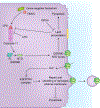Innate immunity to intracellular LPS
- PMID: 30962589
- PMCID: PMC7668400
- DOI: 10.1038/s41590-019-0368-3
Innate immunity to intracellular LPS
Abstract
Monitoring of the cytosolic compartment by the innate immune system for pathogen-encoded products or pathogen activities often enables the activation of a subset of caspases. In most cases, the cytosolic surveillance pathways are coupled to activation of caspase-1 via canonical inflammasome complexes. A related set of caspases, caspase-11 in rodents and caspase-4 and caspase-5 in humans, monitors the cytosol for bacterial lipopolysaccharide (LPS). Direct activation of caspase-11, caspase-4 and caspase-5 by intracellular LPS elicits the lytic cell death called 'pyroptosis', which occurs in multiple cell types. The pyroptosis is executed by the pore-forming protein GSDMD, which is activated by cleavage mediated by caspase-11, caspase-4 or caspase-5. In monocytes, formation of GSDMD pores can induce activation of the NLRP3 inflammasome for maturation of the cytokines IL-1β and IL-18. Caspase-11-mediated pyroptosis in response to cytosolic LPS is critical for antibacterial defense and septic shock. Here we review the emerging literature on the sensing of cytosolic LPS and its regulation and pathophysiological functions.
Figures


References
-
- Takeuchi O & Akira S Pattern recognition receptors and inflammation. Cell 140, 805–20 (2010). - PubMed
-
- Friedlander AM Macrophages are sensitive to anthrax lethal toxin through an acid-dependent process. J Biol Chem 261, 7123–6 (1986). - PubMed
-
- Zychlinsky A, Prevost MC & Sansonetti PJ Shigella flexneri induces apoptosis in infected macrophages. Nature 358, 167–9 (1992). - PubMed
Publication types
MeSH terms
Substances
Grants and funding
LinkOut - more resources
Full Text Sources
Other Literature Sources
Miscellaneous

